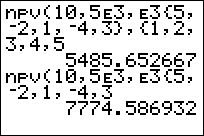TI-BASIC:Npv
Command Summary
Computes the net present value of money over a specified time period.
Command Syntax
npv(interest rate,CF0,CFList[,CFFreq])
Menu Location
Press:
- 2nd FINANCE (on a TI-83) or APPS (TI-83+ or higher) to access the finance menu
- On the TI-83+ or higher, select the first option "Finance..." from the APPS menu
- 7 or use arrow keys to scroll to it
TI-83/84/+/SE
2 bytes
The npv( command computes the net present value of money over a specified time period. If a positive value is returned after executing npv(, that means it was a positive cashflow; otherwise it was a negative cashflow. The npv( command takes four arguments, and the fourth one is optional:
- interest rate -- the percentage of the money that is paid for the use of that money over each individual period of time.
- CF0 -- the initial amount of money that you start out with; this number must be a real number, otherwise you will get a ERR:DATA TYPE error.
- CFList -- the list of cash flows added or subtracted after the initial money.
- CFFreq -- the list of frequencies of each cash flow added after the initial money; if this is left off, each cash flow in the cash flow list will just appear once by default.
Sample Problem
Your mom recently opened a bank account for you, with $500 as a gift to start you off. This is welcome news to you, until you find out that the bank charges 5% as the interest rate for the account. So, you get a job at Rocco's Pizzas delivering pizzas, which brings in $1,000-$2,000 each month. For the last five months, in particular, you have earned $1,250, $1,333, $1,575, $1,100, and $1,900. (Assume there are no other expenses, such as gas, car payment, etc.)
Plugging in all of the different values into the npv( command, this is what our code looks like:
:npv(5,500,{1250,1333,1575,1100,1900
Optimization
The npv( command's optional fourth argument should be left off if each cash flow of money in the list of cash flows just appears once.
:npv(5,1550,{2E3,3E3,4E3},{1,1,1
can be
:npv(5,1550,{2E3,3E3,4E3
At the same time, if there are cash flows that occur multiple times, it can be smaller to just use the frequency argument:
:npv(8,0,{200,200,300,300,300
can be
:npv(8,0,{200,300},{2,3
Formulas
Without a frequency list, the formula for npv( is the following: Math \definecolor{darkgreen}{rgb}{0.90,0.91,0.859}\pagecolor{darkgreen} \operatorname{npv}(i,\operatorname{CF}_0,\{\operatorname{CF}_j\})=\sum_{j=0}^N{\operatorname{CF}_j\left(1+\frac{i}{100}\right)^{-j}} /math
When a frequency list is used, the same formula can be applied if we expand the list with frequencies into a long list without frequencies. However, it's possible to do the calculation directly. We define the cumulative frequency S,,j,, as the sum of the first j frequencies (S,,0,, is taken to be 0):
Math \definecolor{darkgreen}{rgb}{0.90,0.91,0.859}\pagecolor{darkgreen} \operatorname{npv}(i,\operatorname{CF}_0,\{\operatorname{CF}_j\},\{n_j\}) =\operatorname{CF}_0+\sum_{j=1}^N{\operatorname{CF}_j\left(1+\frac{i}{100}\right)^{S_{j-1}}\frac{(1-(1+\frac{i}{100})^{-n_j})}{i}} /math
Error Conditions
- ERR:DATA TYPE is thrown if you try to use anything other than a real number for the interest rate.
- ERR:DIM MISMATCH is thrown if the list of cash flows and the list of cash flow frequencies have different dimensions.
